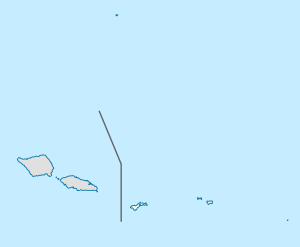Amerika Samoa is the regional anthem of American Samoa. Composed by Napoleon Andrew Tuiteleleapaga and written by Mariota Tiumalu Tuiasosopo, it was officially adopted in 1950.

Fagatogo is the downtown area of Pago Pago. Located in the low grounds at the foot of Matafao Peak, it was the location of the first American settlement on Tutuila Island. It includes the sub-village of Malaloa. Today, Fagatogo is the government, commercial, financial, and shipping center of Tutuila. It is also the administrative capital of American Samoa. It is the location of the American Samoa Fono (legislature), and is listed in the Constitution of American Samoa as the territory's official seat of government. Its population is 1,737.

Poloa is a village in American Samoa. It is located at the west side of Tutuila in the Alataua District. The village has 193 residents in 2010. The main denominations in the area are Methodist and Christian. Poloa has one elementary school. It is located in Lealataua County.

Vaiʻava Strait is the name of a narrow strait located in Vatia, American Samoa. It is a 250 acres (100 ha) National Natural Landmark. The strait is a great example of cliffs formed by waves on volcanic rock. The strait consists of communal lands. It was designated as a U.S. National Natural Landmark in 1972. Vai'ava Strait separates the 420 feet (130 m) high Pola Tai Island from Polauta Ridge. Pola-Uta is connected to the village of Vatia on Tutuila Island. Pola Tai is a 400 feet (120 m) cliff that is an important nesting area for the fua'ō and tava'e. Hunting of brown boobies, known as the A'ega o le Pola, was a tradition carried out by Vatians in the past. Pola Tai includes Matalia Point, Cockscomb Point and Polauta Ridge.

Leone is the second-largest city on Tutuila Island's west coast. The village is on the south-west coast of Tutuila Island, American Samoa. Leone was the ancient capital of Tutuila Island. Leone was also where the Samoan Islands’ first missionary, John Williams, visited on October 18, 1832. A monument in honor of Williams has been erected in front of Zion Church. Its large church was the first to be built in American Samoa. It has three towers, a carved ceiling and stained glass. Until steamships were invented, Leone was the preferred anchorage of sailing ships which did not risk entering Pago Pago Harbor. Much early contact between Samoans and Europeans took place in Leone.

The following outline is provided as an overview of and topical guide to American Samoa:

A'oloau is a village in the west of Tutuila Island, American Samoa. It is located inland, 5 miles (8 km) southwest of Pago Pago. It is also known as A’oloaufou, which means "new A’olou". An abandoned area in town by A'oloau Bay is known as A'oloautuai, which means Old A’oloau’. A'oloau's nickname is Nuu Puaolele which means the Fog Village.

Pago Pago Harbor on Tutuila Island in American Samoa is one of the world's largest natural harbors. The capital, Pago Pago is located on the inner reaches of the harbor, close to its northwesternmost point. It has the highest annual rainfall of any harbor in the world. It is also considered one of the best and deepest deepwater harbors in the South Pacific Ocean or in Oceania as a whole. Pago Pago Bay is over 400 feet (120 m) deep and two miles (3.2 km) long. As part of the Pago Volcano caldera, the harbor is 50% landlocked,
The Samoa News is a newspaper published in Pago Pago, American Samoa. In 1981, Samoa News was the major newspaper distributed in both of the Samoas. In January 1985, Lewis Wolman became editor of Samoa News. The Samoa News Ltd. was established in 1986, with Fuga Teleso as the majority shareholder. Wolman purchased Teleso's shares on November 18, 1986, and became the publisher-editor for Samoa News. It began printing on a web press in December 1989, allowing for an increase in paper size. In January 1990, it became the first daily newspaper in America Samoa, printed at its new facilities in the downtown Pago Pago location in Fagatogo. Fuga Tolani Teleso was Chairman of the board.

The Jean P. Haydon Museum is a museum in Pago Pago dedicated to the culture and history of the United States territory of American Samoa. It contains a collection of canoes, coconut-shell combs, pigs’ tusk armlets and native pharmacopoeia. It also houses exhibits on natural history, tapa making, traditional tattooing, as well as a collection of war clubs, kava bowls, and historic photographs. Constructed in 1913 as U.S. Naval Station Tutuila Commissary, the building was home to Tutuila Island's Post Office from 1950 to 1971. The museum has displays of various aspects of the Samoan Islands’ culture and history. It is the official repository for collections of artifacts for American Samoa. Funded by the American Samoa Council on Arts, Culture and the Humanities, it is the venue used for numerous of the cultural resource activities in American Samoa.
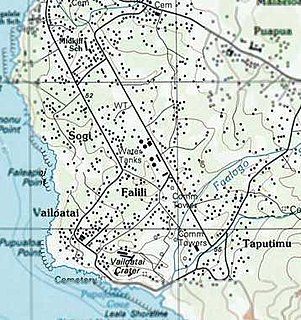
Vailoatai is a village in southwestern Tutuila, the main island of American Samoa. It is located on the eastern end of Leone Bay. The village is known for its beautiful malae located along the island's rugged southern coast, lined by the fale tali mālō of its village chiefs.

Vatia is a village on Tutuila Island in American Samoa. It is a north shore village located on Vatia Bay. The road to Vatia, American Samoa Highway 006, is the only road going through National Park of American Samoa. Vatia is a scenic community at the foot of Pola Ridge and surrounded by the national park. It is only reached by Route 6 which traverses the national park before reaching Vatia. There was once a hiking trail over Maugaloa Ridge from Leloaloa, but since the completion of Route 6, this trail is now overgrown. It is home to a beach, and panoramic views of jungle-covered peaks surround the village on all sides. Vatia is the center of the Tutuila-section of National Park of American Samoa. It is located in Vaifanua County.

Maʻopūtasi County is located in the Eastern District of Tutuila Island in American Samoa. Maʻopūtasi County comprises the capital of Pago Pago and its harbor, as well as surrounding villages. It was home to 11,695 residents as of 2000. Maʻopūtasi County is 6.69 square miles (17.3 km2) The county has a 7.42-mile (11.94 km) shoreline which includes Pago Pago Bay.

Fagasā is a village in the Eastern District of Tutuila Island in American Samoa. The village lies by Fagasa Bay, on the north shore of the island. Its name is Samoan and translates to “Forbidden Bay.” The village borders the Tutuila-section of National Park of American Samoa. The trailhead to Mount ‘Alava is located near the village by Fagasa Pass.

Sa'ilele is a village on the north shore in the Eastern District of Tutuila Island in American Samoa. It is reached from a cross-island road which leads north from the village of Faga'itua. By turning off at the pass, the turn-off takes you down a narrow road through dense forest to Sa'ilele. The village is known for having some of Tutuila's best swimming beaches. The sandy area below the rock outcrops at the western end of the beach is also a popular site for picnics. On a track east of the village is a burial ground where some ali'i were buried.
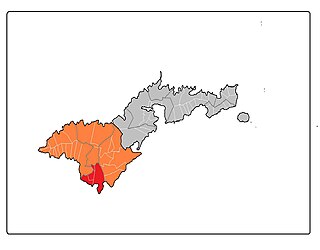
Tuālā-tai County is one of the five counties that make up the Western District of American Samoa.
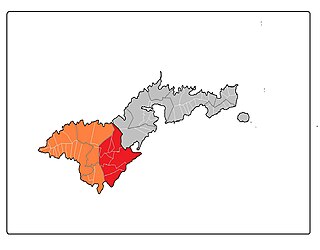
Tuālāuta County is a county in the Western District in American Samoa. It is the largest and also the most populated county in American Samoa. The county is represented by two seats in the Senate and two seats in House of Representatives in the American Samoa Legislature. 'Ili'ili is the principal place in Tualauta County, a county which consists of 'Ili'ili, Vaitogi, Saleauau, Tafuna, Pavaia'i, and Faleniu.
Malaloa is a sub-village of Fagatogo and is located at the end of Pago Pago Harbor in American Samoa. It is located in-between Fagatogo proper and the village of Pago Pago. Cruising boats entering and leaving Pago Pago should clear at Malaloa Marina. The Malaloa Marina was opened for cruisers’ use and has added a customs wharf to handle inbound and outbound clearances.
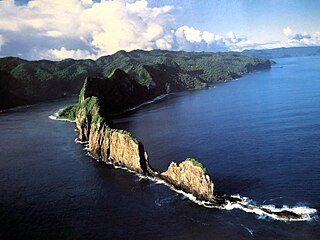
Pola Island is an island just offshore from the village of Vatia on Tutuila Island in American Samoa. It is also known as Cockscomb. Pola Island is designated as part of the National Park American Samoa, and is a popular tourist attraction. It is located on the west side of Vatia Bay, and serves as both a landmark and an icon for Vatia. Pola Island has been named one of American Samoa's Seven National Wonders by the Pago Pages. It has been named "the most beautiful natural feature of Tutuila Island” by travel guide publisher Lonely Planet. Pola Island is known for its high cliffs, populated by seabirds, and is one of American Samoa's primary seabird nesting sites.
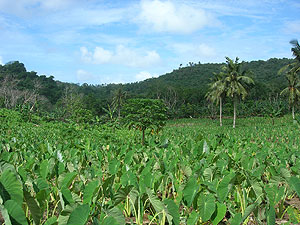
Fogama'a Crater is a valley basin on Tutuila Island, American Samoa, immediately north of Larsen Bay. It is within the village of Futiga, just below Logotala Hill. It is also known as Hidden Beach or Larsen’s Cove.
